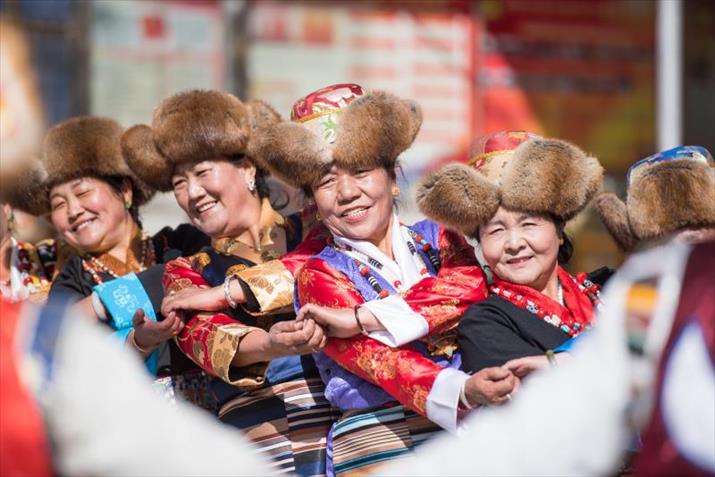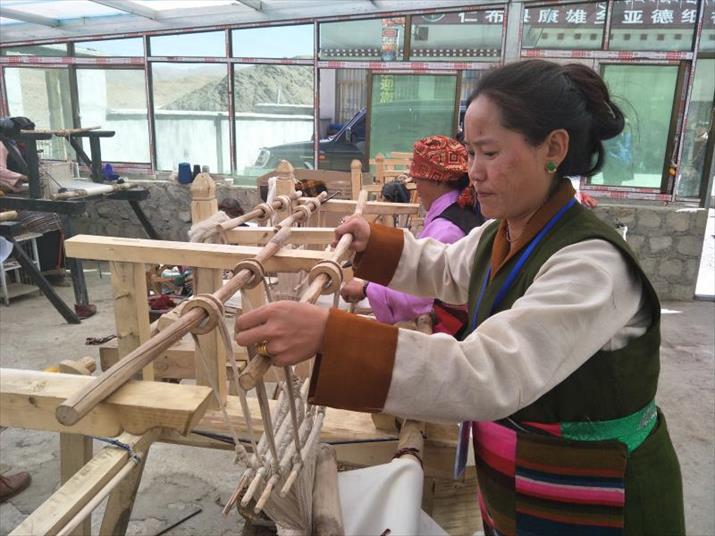|
||||||||||
| Home Nation World Business Opinion Lifestyle ChinAfrica Multimedia Columnists Documents Special Reports |
|
||||||||||
| Home Nation World Business Opinion Lifestyle ChinAfrica Multimedia Columnists Documents Special Reports |
| China |
| The Golden Fleece |
| Tibet overcomes poverty with rural industries based on ancient crafts and modern husbandry |
| By Li Nan | BEIJING REVIEW ·2017-03-17 |

Lhachung makes nearly 5,000 yuan ($722.6) a month. The rural weaver from southwest China's Tibet Autonomous Region amasses an earning that is 532 yuan ($77) higher than what the nation's urban residents earned on an average per month in 2015, a far cry from the days when her family struggled under the poverty line and subsisted on relief funds.
Once a housewife without any means of income, Lhachung attributes the change to the establishment of a weaving cooperative close to her house in Khamshong, a town in Xigatze, 263 km southwest of Lhasa, capital city of the autonomous region.
The cooperative was founded under Namdrol, a 30-year-old Yadexihe expert, with the help of the local government in 2013. Yadexihe is a fabric made of the wool of sheep living in altitudes of 4,500 meters above sea level. The fluffy and warm fabric, colored with natural dyes, has a 1,200-year-old history and in the past, was used exclusively by local high-ranking religious leaders.
Old crafts, new life
Born into a Yadexihe weaver's family, Namdrol had been making the fabric since 2005 but found that working solo was not productive. "When I weaved and sold my clothes myself, I didn't have a brand and my products fetched a low price," she told Beijing Review. "I could earn only 20,000 yuan ($2,894) a year."
At the end of 2013, the local government encouraged rural housewives to start the Yadexihe Woolens Cooperative led by Namdrol. The government funded their preliminary training and provided basic equipment as well as a soft loan, said Wangla, Chief of Khamshong.
In less than three years, the cooperative has flourished. In 2016, it reported a net profit of 1.35 million yuan ($195,327). Besides making money, it is providing jobs to 30 housewives and people with disabilities from nearby villages, pulling 20 households out of poverty.
Besides, the cooperative helps to preserve and revitalize the ancient Tibetan weaving craft. "There were only four to five proficient Yadexihe weavers three years ago. The craft was almost lost," Namdrol pointed out.
Once the cooperative was started, orders have been pouring in. "Our supply is falling short," Namdrol said. "And more people are willing to learn the old crafts, which is the best way to preserve it."
Of the 30 employees, 23 are now skillful weavers. In 2013, Namdrol was named regional inheritor of the Yadexihe craft as part of the regional government's effort to protect Tibetan intangible cultural heritage.
Data from the regional government show that 350 intangible cultural heritage inheritors had been named by the end of 2014. Every inheritor is entitled to a 10,000-yuan ($1,446.5) subsidy per year—the third highest inheritor subsidy after Beijing and Guangdong Province in south China—to popularize their crafts and train others.
With the inheritors acting as bellwethers, cooperatives producing traditional Tibetan boots, costumes, mats and paper have sprung up on the roof of the world. In the recent decade, a 160-million-yuan ($23.14 million) fund has been allocated to protect Tibetan intangible cultural heritage.
In the 2017 Report on the Work of the Government released on March 5, Premier Li Keqiang said China's cultural relics and intangible cultural heritage would be given effective protection and enabled to play fuller roles in today's society.
Namdrol's biggest dream is to have more people practice the crafts and increase their incomes. "We will enlarge the cooperative to offer more jobs to the poor and people with disabilities," she said.
Nowadays, through developing industries based on traditional crafts such as wool weaving and making boots and Tibetan handmade paper, rural impoverished Tibetans have shaken off poverty.
"In 2016, 130,000 Tibetans from 1,008 villages were pulled out of poverty," said Qizhala, Chairman of the Tibet Autonomous Region Government.
Incubating rural industries suited to local conditions, relocating inhabitants from isolated high-altitude areas, and providing free professional training are among the key measures the regional government is using to help the impoverished.
"Developing industries is the core driver for a sound cycle of poverty relief. We should not try to lift people out of poverty only by preferential policies and financial support of the government," Qizhala said.

| 2Next |
| About Us | Contact Us | Advertise with Us | Subscribe |
| Copyright Beijing Review All rights reserved 京ICP备08005356号-5 京公网安备110102005860号 |